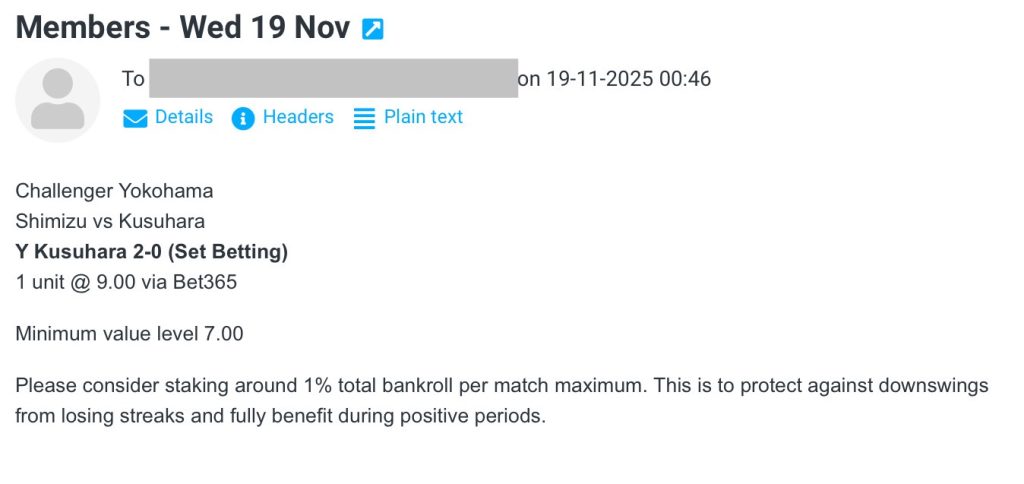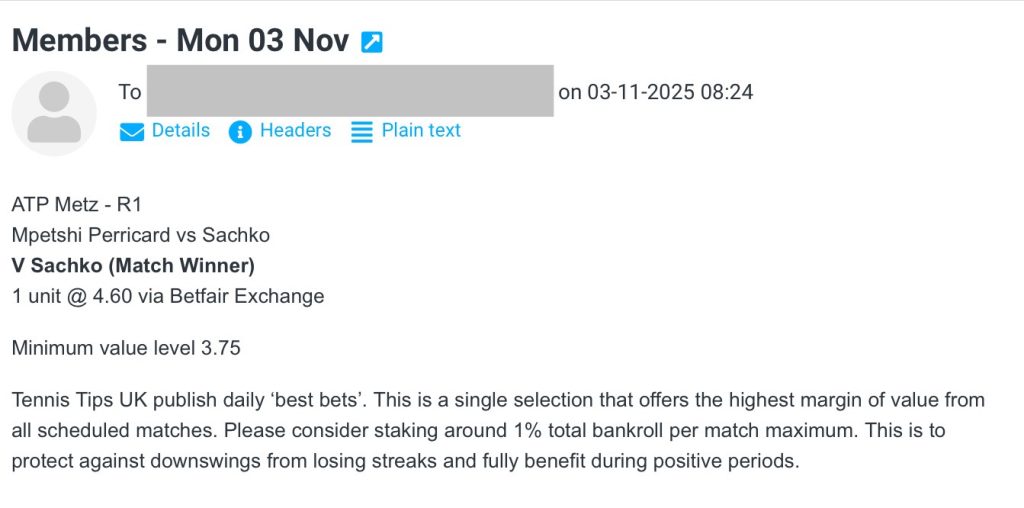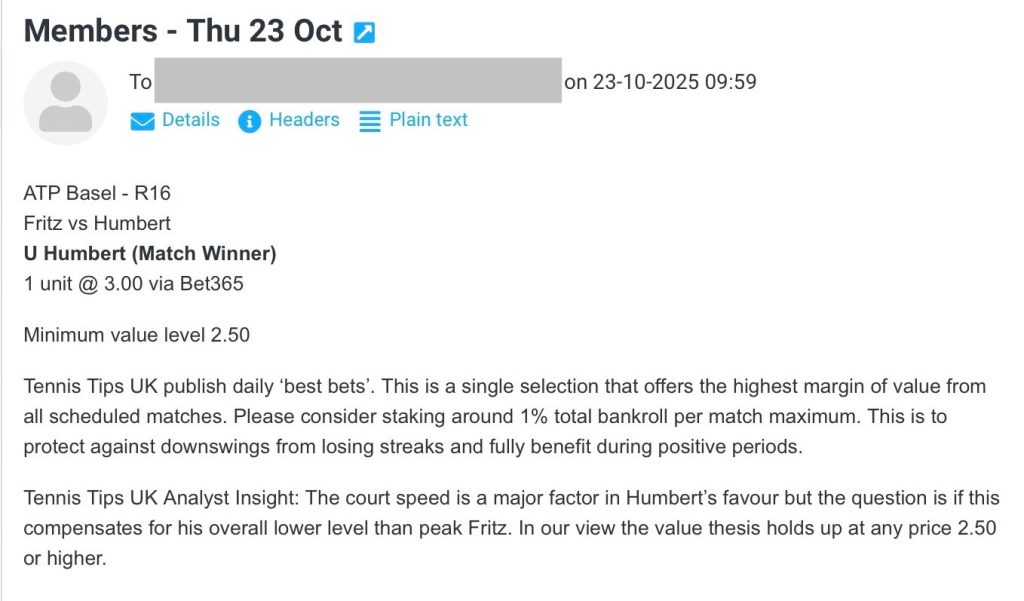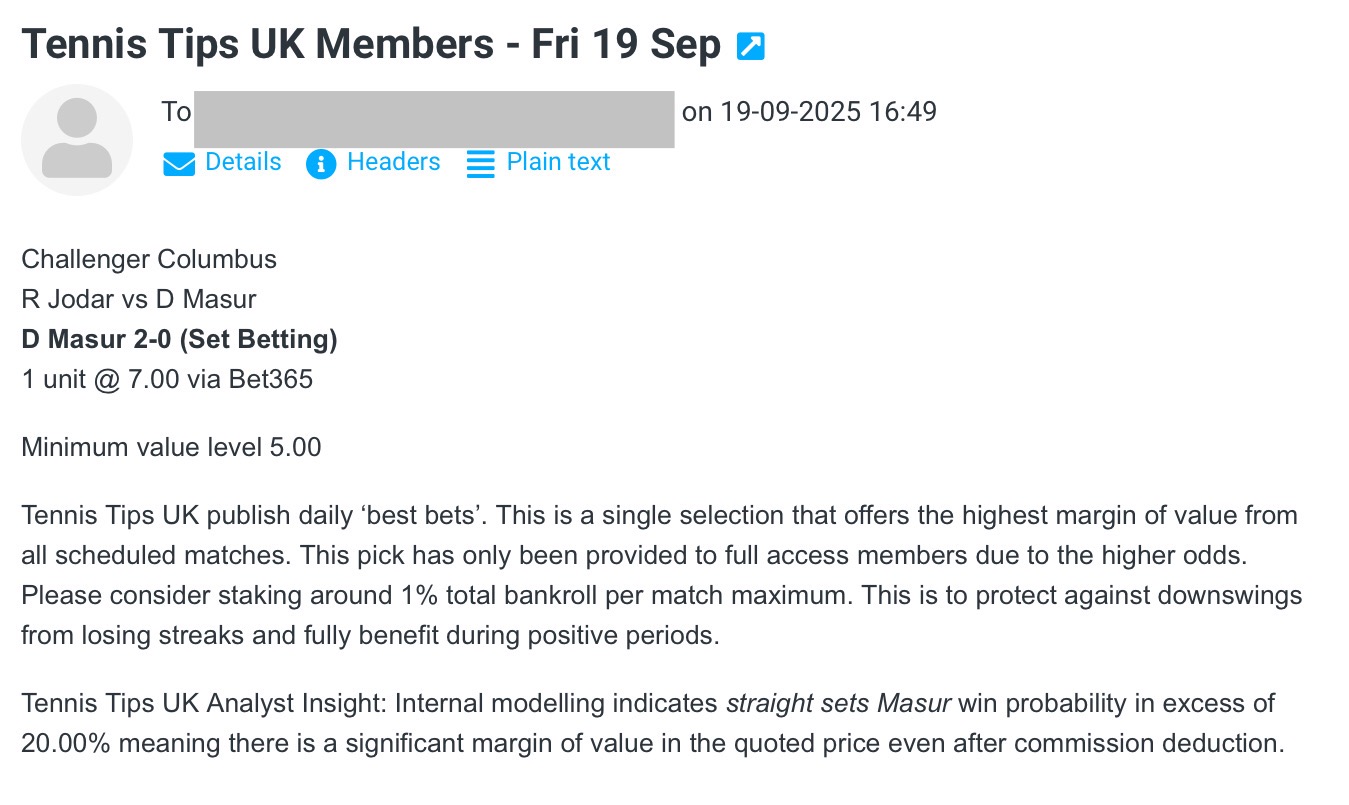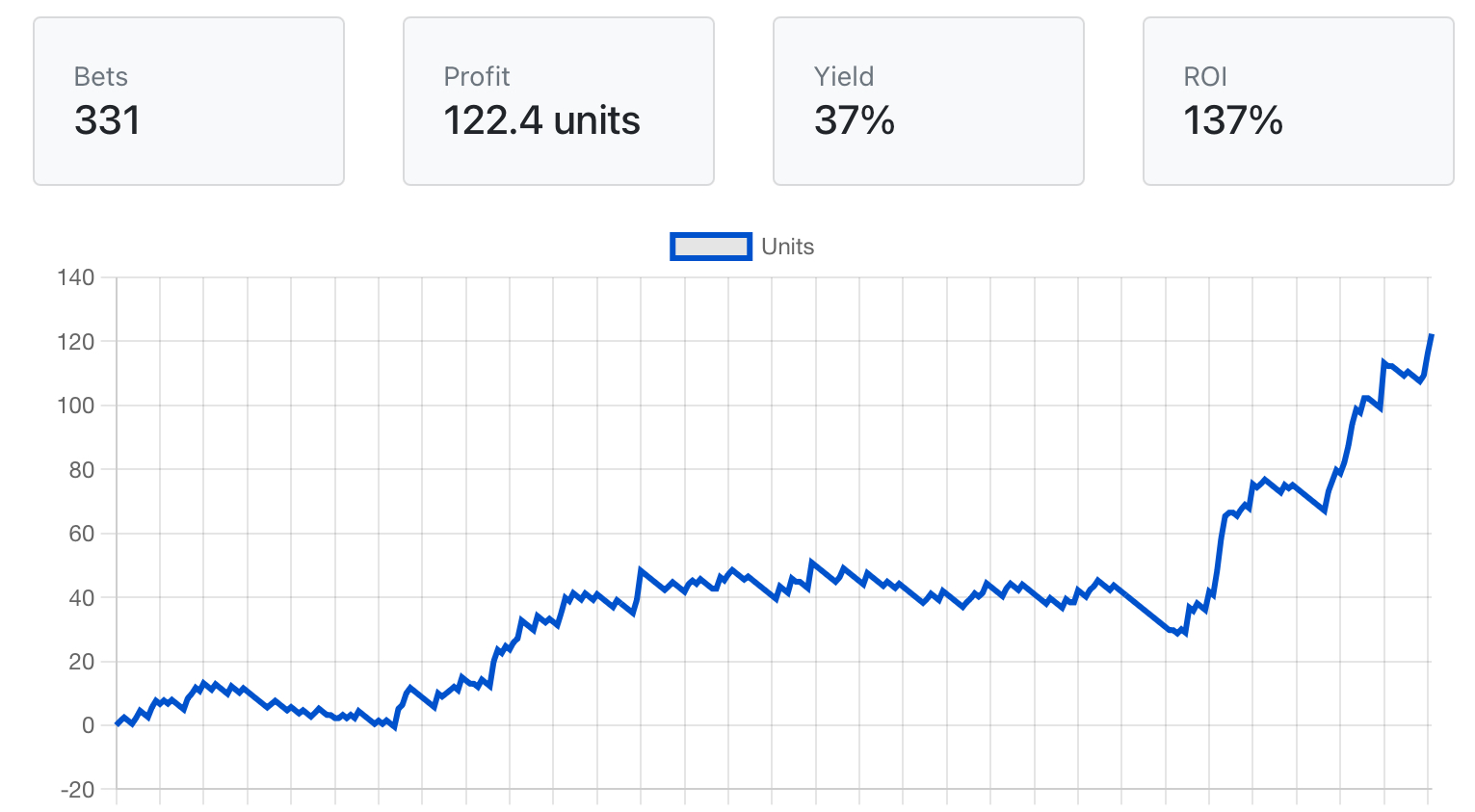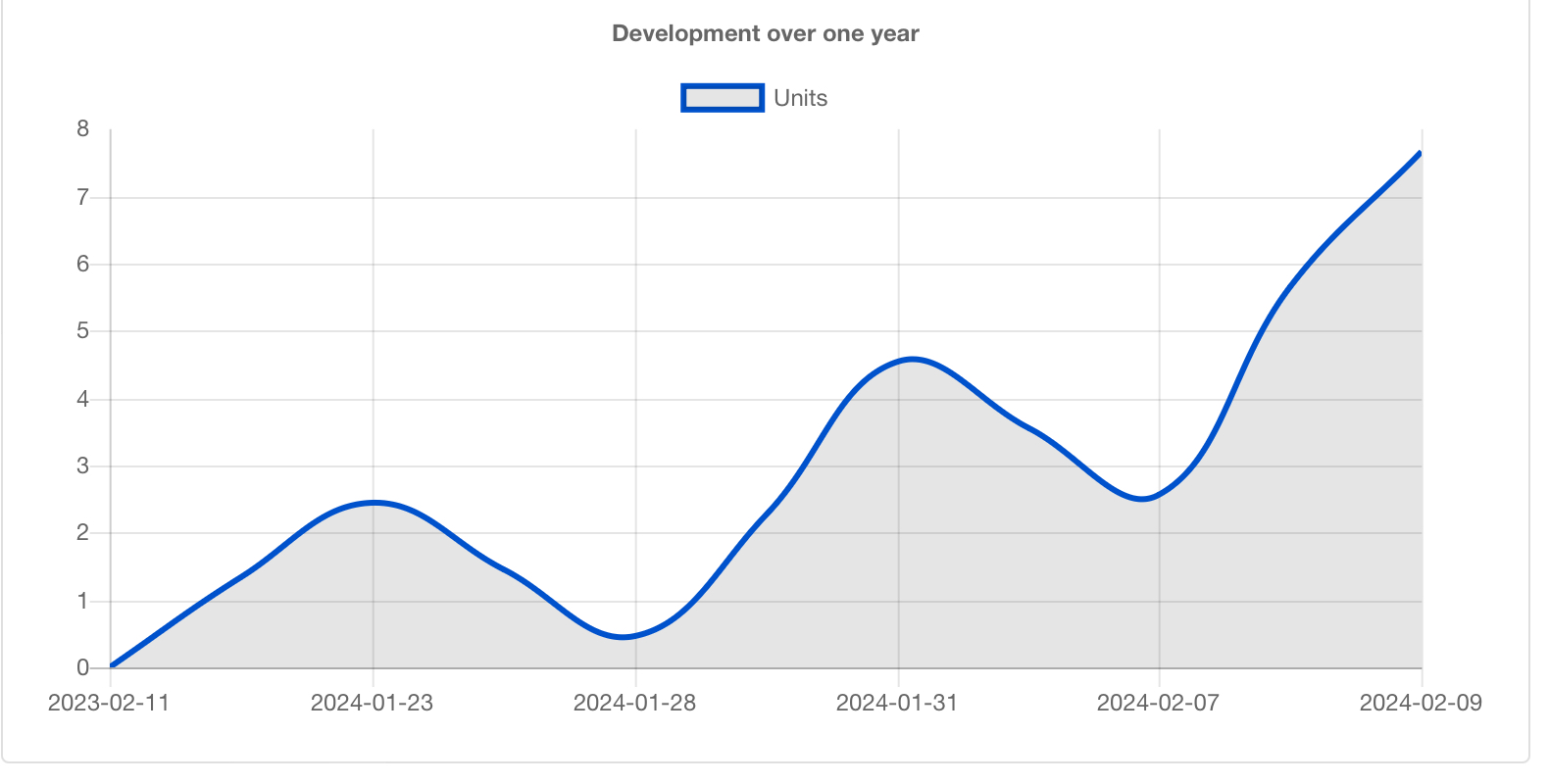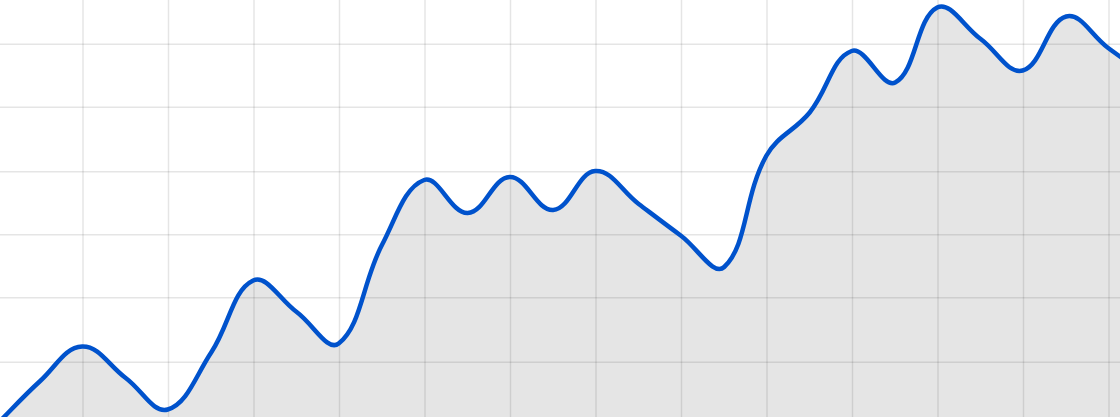Tennis Tips UK have a dedicated team who have operated since 2013. Their job is to analyse all scheduled ATP, Challenger & Grand Slam tennis matches with the objective of identifying the single best bet from across all markets. Members then receive this direct to their inbox. They are strict in terms of minimum value thresholds so expect around one pick per week on average. Quality over quantity is a core pillar of their success.
First time member? Enter code: TTUK10 on the sign up page to reduce the cost by 10%. This is strictly available one time for genuine new clients only. There is also the option to pay in Euro (€) or Dollars ($) in which case the same discount will be provided in that currency. The service is completely digital and delivered direct to your registered email inbox. One time payment. No subscriptions or recurring charges.
| Profit (units) | Yield (%) | Strike Rate (%) | Average Odds (Decimal) | Illustrative Return (£100 staked per pick) |
| +118.40 | 33.80 | 34.00 | 4.84 | £11,840 from backing every selection as of November 2025 |
Recent Winning Bets
Tennis Betting Systems & Strategy
In the UK at least, the vast majority of money wagered upon the gambling industry is spent on football and horse racing betting, and as two of the most popular sports that the country has to offer that will come as no great surprise.
But it is strange to think that more punters don’t bet on tennis, what with its myriad of available markets and almost constant action 365 days a year. Let’s face it, punters even have a 50/50 chance of their chosen player winning (assuming traders have valued them in the 1.91-2.00 range) before a ball is even hit, and with research and insight we can even take some of the edge back from the bookmakers. With that in mind, there is no better time to start your tennis betting adventure than right now with tennis betting systems.
The Basics of Tennis Betting
It’s likely that you know about the sheer mechanics of tennis, but you may not be aware of how the sports is governed
There are four Grand Slam events each year – the Australian Open, French Open, Wimbledon and the US Open – and these are, ultimately, the tournaments that every player wants to win. The ranking points gained alone offer successful players various exemptions and opportunities to make money (the end of the season World Tour Finals being one such example), and so here very few shock results are experienced.
The second tier of tennis events are the Masters 1000 collection, and these take place throughout the calendar year and on various surfaces too. It I likely that the world’s best players will enter these given the prize money, ranking points and prestige on offer.
The bread and butter of the tennis tours are the ATP and WTA 500 and 250 events, which take place almost every week during the season (apart from when the Grand Slams are run), and these offer much less in terms of cash/ranking points they do offer a good opportunity to win titles (the top players tend to pick and choose which 500 and 250 events they play), plus a chance to get in good form prior to a more prestigious competition. Each player will typically enter these tournaments on their favourite surface.
Below that comes the Challenger and ITF Tours, which are typically made up older players in the twilight of their careers, young starlets who are still learning the game and those injury-prone professionals that have fallen off the main tour ladder. These are typically swerved by punters, due to the unpredictable nature of the players involved.
Tennis Betting Markets
As with any sport, there are a number of different options available in terms of markets to explore. Yes, you can simply bet on the winner of a tournament or a match if you want, and this can be a profitable way of going about your business. Find out more about tennis betting markets in this comprehensive guide. But in those matches where no value can be found, the side markets are often a fantastic way of creating profit-making opportunities. Here’s the pick of the bunch:
Quarter Winner
Many larger tournaments will offer a market for Quarter Winner. As you are probably aware, tennis events are drawn in brackets, which makes it possible to chart a player’s progress through a particular event and second-guess who their opponents will be in the latter stages. With such foresight, we can predict a quarter winner with some degree of certainty; particularly in the Grand Slams where seedings are a true reflection of a player’s ability.
Set Betting
There will be occasions where you fancy Player A to win comfortably, so either two or three sets to nil, and there will be other instances where you foresee a closer contest which could go the distance. Set Betting enables punters to leverage greater profit in one-sided contests, so backing Novak Djokovic to win his first round match at a major 3-0, for example.
Total Games
Again, the proximity in quality between the players will dictate how many games are played. On a slower surface that offers break of serve chances, it’s no surprise when a player wins 6-1 6-2, and as such the Total Games played will fall into the lower bracket. Conversely on hard courts and grass where it is harder to break serve, the number of tie breaks or 7-5 sets is greater, and this naturally pushes the Total Games count higher.
Tie Break in Match/Correct Score
There are some players who are just so strong at serving – yet so weak at returning – that their matches, particularly on grass or hard courts, are almost bound to end up 7-6 7-6. The likes of John Isner, Ivo Karlovic and Feliciano Lopez are tie-break specialists, and so the opportunity to profit from their excellent serve is available. There is even the opportunity to ‘Dutch’ the correct score market: e.g. if Lopez is playing Isner we could bet on 7-6 to the Spaniard and also 7-6 to the American and yield a profit no matter who triumphs.
First Set Winner
‘He who serves first, serves last’, goes the old saying. Basically, this means that whoever wins the coin toss and elects to serve first typically will later serve for the set. Note though that this only rings true for players with the service game to actually get the job done.
Handicaps
This market once again requires some insight into how tightly-found a match may be. Fancy one player to walk away with it? Great, back them with a healthy minus handicap. Think an underdog will perform well, even if they don’t quite get over the line? A plus handicap is a great way to back such an outcome, e.g. backing Player B with a +4.5 handicap yet they lose 6-4 7-5. Our handicap clears the actual result, and so our bet is a winner.
How to Stake Smart
There are thousands of tipsters and ‘experts’ operating online and on social media who promise their followers the earth, yet in reality they deliver very little. Why? Because there is simply no quick way to tennis betting success.
The sport is beautifully unpredictable – that’s why we love watching it, and unpredictability is ultimately the punters’ worst enemy. As such, we must be sensible and adopt a cautious approach if we want to achieve long term profits from our betting activity. The Internet messiahs may wax lyrical about a particular betting system or strategy, but in truth with tennis shock results happen each and every day; rendering betting systems meaningless.
Most successful bettors run their account like a professional business: they set aside a bankroll per week or month and stick to it religiously. If this bankroll drops down to zero during the specified time period (and with our help hopefully it won’t!) then that’s it; your betting for the week/month is over. At the end of the time period, any amount of money over the budget can be withdrawn to your bank account, and then you can start again with the same bankroll next time around.
The general wisdom is to implement a flat staking policy too. This will help you to monitor losses more effectively and ensures you don’t fall into the trap of many an unsuccessful punter: chasing losses by betting big. Usually, a stake of 5% is the preferred option – this accounts for losing streaks, that do happen occasionally, of up to 20 bets.
Analysing Tennis Matches
In Grand Slam matches, the best man usually wins; hence why Djokovic, Andy Murray, Roger Federer and Rafa Nadal have dominated the sport for the last decade. The women’s game is slightly more unpredictable, although Serena Williams’ huge haul of major trophies would suggests otherwise.
But there are dozens of tennis matches played almost every day, and identifying value bets amongst the schedule should become your number one priority Happily, there are a number of handy hints and tips that can help you to do this.
Player A takes on Player B in a best-of-three set match. They both have a 50% chance of winning, right?
Well, no actually. While some matches have that ‘flip of a coin’ feel to them, often with research into a player’s form and proclivity for winning on a particular surface or at a certain location, we can actually give one player or the other an edge. Some players are just better than others, that’s fact, but often we can predict the outcome of a match by digging a bit deeper.
Number Crunching
Current form is an essential component of a player’s make up, and without it their chances of winning are clearly shorter than if they are confident and buzzing about their game.
But form can be interpreted in different ways, and it’s not just winning matches. If a player has scraped through the first round of a tournament with a first serve percentage of just 50%, then what is likely to happen if they remain at that level in the next round against a better opponent? What if their unforced error count is off the scale, but their first round opponent was just as bad?
Luckily, these kinds of stats are readily available online, so the resources are there for us to use to our advantage.
Head-to-Head
Some players just have a habit of beating others; often it is for obvious reasons, e.g. some just really struggle against left-handers, for whatever reason, while in other instances the cause of the disparity is a little less clear to see.
There are some fantastic websites out there, Match Stat is one of them, that have head-to-head records published for pretty much any player ever to pick up a racquet. If you can find contests where one player has a 3-0 lead or greater over another, in matches played within the last two years, then that is a crucial betting angle in.
Surface Specialist
Typically, Spaniards and South Americans enjoy playing on clay courts, while Americans prefer hard surfaces. Why? It’s quite simple: these are the courts that they are typically born and raised upon.
It is not always as straightforward as that, but you will find that most players perform better on one particular surface than others. Why else do you think it took Novak the best part of a decade to win the French Open?
Grass and hard courts play faster and bounce less than clay, while the red stuff suits good movers who can manoeuvre the ball around with great angles. Someone like 6ft 7in Ivo Karlovic struggles to move well on clay like the shorter guys, and yet his 140mph serves are given extra venom by a faster surface. Tennis is often a case of horses-for-courses.
Motivation, Injuries and Tiredness
We’ve linked these three things together as they can often indicate whether a player’s body and/or mind are up for the test.
A player returning from an injury will very rarely hit top form straight away; particularly when the injury suffered was one of huge relevance, e.g. a shoulder or elbow operation.
Similarly, players who have endured a hectic schedule – maybe they have just won a rigorous clay court tournament in baking heat, will struggle to recapture their best form next time they take to the court. Sometimes the mind is willing, yet the body unable.
And what about when the mind is unwilling? Some players struggle for motivation at certain tournaments. Maybe they are miles from home and just want to get the next flight back, or are playing the week after a Grand Slam success. Players lacking in motivation are at their most vulnerable, and yet conversely those who are ‘up for it’ can deliver previously unseen quality performances. A player participating in their home tournament would be one such example.
Finding Tennis Betting Value
Value is perceived, rather than tangible, and so we all have different opinions on what does and doesn’t constitute value. However, we must make one thing very clear: just because a player is 5/1 does not mean they are good value, and if a favourite is 1/5 that does not necessarily mean they are bad value!
The best example of this in action can be found in the Grand Slams. Each Slam event has 32 seeds, and here is how many of those made it past the first round at each of this year’s majors (to the time of writing):
Men’s:
Australian Open: 27 (84%)
French Open: 26 (81%)
Wimbledon: 28 (88%)
Women’s:
Australian Open: 20 (63%)
French Open: 23 (72%)
Wimbledon: 29 (91%)
So barring the anomaly that was the women’s Australian Open, it is fair to say that there is a value to be had in backing any of the top 32 seeds in the first round of a major; regardless of their price.
Normally, smart punters won’t place accumulator bets or multiples; they know this is what bookmakers want them to do, as each selection decreases their chances of winning. But canny bettors will utilise multiple bets with a ‘cover’ angle, e.g. Lucky 15 or Yankee, so that if one selection lets them down then they still have an opportunity to make a healthy profit.
Finding tennis betting value is hard, particularly when you become preoccupied with odds and prices. Realistically, we’re looking for an above average chance of winning, rather than a great price, for factors ranging from current form, good head-to-head record, one player suffering with fatigue etc.
Once we start gaining an advantage over the bookmakers by doing our homework, the money side of things takes care of itself.
 TENNIS TIPS UK MEMBERSHIP – How it Works
TENNIS TIPS UK MEMBERSHIP – How it Works
Follow @TennisTipsUKSynopsis: An email service where members receive regular betting picks direct to their inbox. This clearly states the match, specific bet and advised stake. There is a ‘best bet’ which is the highest value selection our team has found across all markets. This is exclusively available through the full access plan. Expect one selection per week.
Who picks the advised bets?Tennis Tips UK have a team of analysts built over the past decade. Each has shown a proficiency in beating ATP, Challenger or Grand Slam markets consistently. See an example of the email format members receive below. To make the service more practical to follow we send out picks six hours before the scheduled start time on average so it should be feasible to follow regardless of client timezone.
Odds sourced from Betfair Exchange, Pinnacle or Bet365. Match winner or set betting / handicap are the market types used.How much profit have the picks made overall?
As of late 2025; a £100 bettor has enjoyed profits in excess of £10,000 assuming they backed the quoted price. Please note the image below is updated once annually – see the link below for the most up to date performance figures.
Full tracking is available publicly via a third party verification platform.How do you profit from tennis betting?There is no single ‘one size fits all’ approach. Tennis Tips UK have been fine tuning the selection process since way back in 2013. For a comprehensive insight into our thesis try exploring our tennis betting research articles.


